Which Reptiles Are Herbivorous?

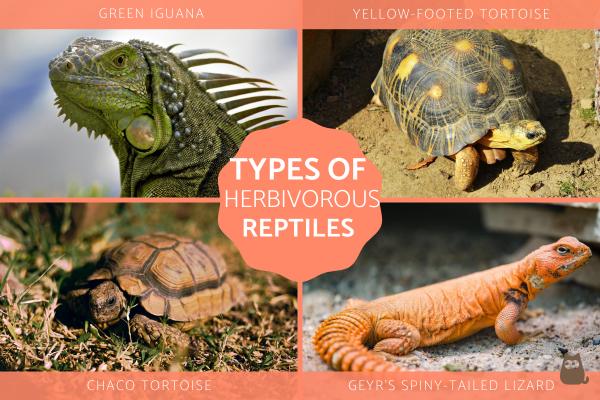
Knowing more about reptiles may be of interest to you because you love these animals. You may even love them so much you want to adopt them into your home. Reptiles need a very specific type of care which not everyone can provide. This means providing a terrarium which mimics their natural environment, ensuring the ambient temperature is correct and providing the correct diet for each type of reptile. Some animal lovers may see this last factor as being prohibitive since their own vegetarian or vegan views means they won't want to feed mice, insects or other animals to their pet. Some people may simply find the process of feeding them off-putting.
At AnimalWised, we ask what reptiles are herbivorous? By providing a list of herbivore reptiles, we can see if any of them will make good companions, as well as learn a little more about the diet of reptiles more generally.
Are there herbivorous reptiles?
The diet of an animal is determined by different factors, many of which are related to their evolutionary adaptation. Much of this has to do with changes in their environment and habitat. All animals can be described as being one of three types according to diet:
- Carnivores: require a diet either mainly or exclusively based on other animals.
- Herbivores: require a diet either mainly or exclusively based on plant vegetation.
- Omnivores: can survive on a diet with more or less food from plant and animal origin.
Some reptiles are apex predators, meaning they have their pick of prey in a given ecosystem. They require animal meat to survive. Others are prey animals themselves and will need to consume smaller animals than themselves.
Due to climactic, environmental and evolutionary factors, the type of food available to certain reptiles can change over time. This means the animal may have to adapt their diet accordingly, eating other types of food to survive. Many types of carnivorous reptile may supplement their diet with vegetation or other foods, even if meat remains the main part of their diet. Omnivorous reptiles can include both, but do not necessarily need meat to survive.
Truly herbivorous reptiles are uncommon. Even certain reptile species which eat a lot of plant vegetation often eat insects or smaller animals to get protein and fat. For an animal to be considered herbivorous, they need to have a diet which requires them to eat either exclusively or mainly plant vegetation, even if some might eat the odd insect if given the opportunity.
The morphology of the animal is very important in their diet. We can see this by comparing two different types of reptiles, snakes and turtles. All snakes are carnivorous. They are supreme predators with great agility, razor-sharp fangs and great muscular strength. Many snakes are also venomous and can paralyze prey before the kill.
Most turtles do not have the same structures which allow them to kill easily. Terrestrial turtles generally move very slow, making it difficult to catch faster prey. Not only do they not have venomous fangs, turtles do not have teeth. They do have keratinized structures which can be very sharp and strong jaws which can clamp down on prey, like those of the alligator snapping turtle.
Sea turtles are generally more agile in their environment, i.e. swimming in the sea. They are often better at catching fish than a terrestrial tortoise is at catching small mammals or other reptiles. Although lizards may spend a lot of time staying still, they can be very fast when they do move and want to catch prey.
With this information in mind, we look at the types of herbivorous reptiles which have a diet mainly of plant origin.
Tortoises
Undoubtedly the most common herbivorous pet reptiles are tortoises. They are also the easiest to maintain if you cover two basic premises. Even if it is small, you will need a garden and the animal must also be compatible with the temperatures in your environment.
The fact they need a garden is motivated by the need for the tortoises to hibernate. They cannot do this in an apartment because they need to bury themselves in the ground to proceed to the hibernation stage. If they cannot hibernate, tortoises will likely experience significant health problems. They may even die if they are unable to hibernate.
Environmental temperature is also important if we want to enjoy a healthy and happy tortoise. What type of temperature and environment they need will depend on their species. You can learn more by looking at our guide to the different types of pet tortoises.
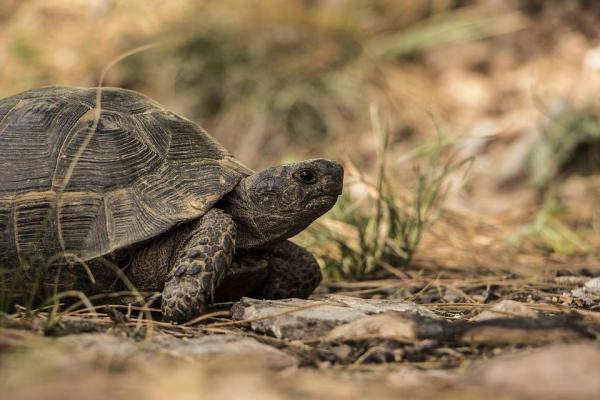
Hermann's tortoise
Mediterranean tortoises are relatively easy to maintain and can allow you to provide them with a herbivorous diet. Their habitat temperature range is very broad and their diet is based on plant food available to everyone. There are two subspecies of Hermann's tortoise which are commonly kept as pets:
- Western Hermann's tortoise (Testudo hermanni hermanni): a very common herbivorous reptile kept as a pet. It should be noted that fruit does not agree with these tortoise because it gives them diarrhea. Their diet should be based on green vegetables such as alfalfa sprouts, lettuce, watercress, rosemary, sage, clover, lettuce and almost any plant or flower from the garden.
- Eastern Hermann's tortoise (Testudo hermanni boettgeri): is of a paler color than the previous and its temperature range is slightly lower. It comes from the Balkan area. Their diet includes endive, spinach, clover, yarrow, dandelion, thistle, lemon balm and many other wild plants (up to 60 plant species). Fruit intake should be minimal and always be given ripe.
Both these herbivorous turtle species will optionally feed on small insects and snails when in the garden. This is because the calcium from the shell will be good for them. However, we can also provide them with calcium preparations available in pet shops. Insufficient calcium can lead to problems such as pyramiding in turtles.
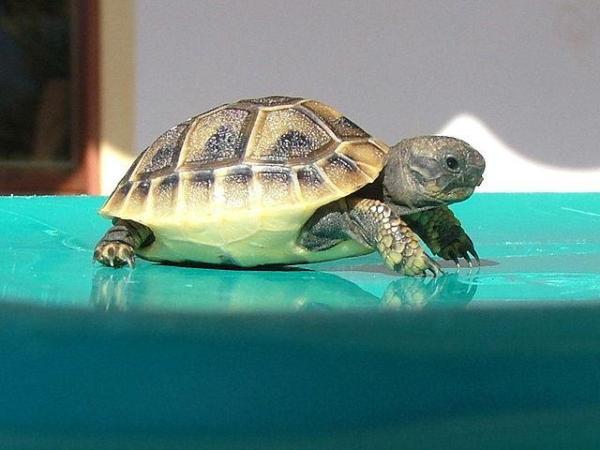
Mexican tortoise
There are various species of Mexican tortoise which are considered herbivorous, but all of these are threatened. One of the reasons for this threat is the removal of the wild animals for sale. We must fight to eradicate this trade. Pets must always come from approved hatcheries or entities involved in the rescue of exotic animals. Next we point out a couple of herbivorous Mexican tortoise species:
- Goode's thornscrub tortoise (Gopherus evgoodei): an endangered species whose main characteristic is that its shell is flatter than most tortoises.
- Desert tortoise (gopherus agassizii): this turtle inhabits the deserts of Mojave and Sinaloa (pictured below). It can weigh up to 15.5 lb/7 kg. It is curently considered threatened in the wild.

Argentine tortoise
There are 2 species of land tortoise in Argentina. Both are threatened by habitat destruction and the pet trade.
- Chaco tortoise (Chelonoidis chilensis): commonly known as the Argentine tortoise, it is an endemic species of Argentina's arid scrub land. Among various plants and fruits also, this herbivorous reptile also consumes cactus. It is the southernmost of the tortoise species.
- (C. chilensis donosobarrosi): some consider this a subspecies of the Chaco tortoise, they are from Mendoza, San Luis, Cordoba and Paraguay. They have a small size (20 cm) and are threatened. Their habitat is the savannah and scrub and hawthorn landscapes.
In the picture we can see the Chaco tortoise:

Colombian tortoise
Colombia is a country that is very rich in tortoise species, where up to 27 species can be found. It is the 7th country in the world with the most tortoises and semi aquatic turtles, and the 2nd in South America after Brazil. River basins of the Orinoco and Amazon are the territories where most turtle species in Colombia proliferate. Unfortunately more than ten species are considered threatened.
Development, communications and livestock have altered the ancestral habitat of various species of turtle. The capture for pet shops has also been a negative influence. Next we show the two fully terrestrial species of the 27 catalogued. The rest are semi-aquatic.
- Red-footed tortoise (Chelonoidis carbonarius): this tortoise is omnivorous, active during the day and of medium size. It can reach 51 cm long. Globally it is not threatened, but within Colombia its situation is critical. This is due to the destruction of their habitat and the illegal hunting of young specimens for the pet trade.
- Yellow-footed tortoise (Chelonoidis denticulatus): a large land turtle that can reach 82 cm in length. Its longevity reaches 80 years. Their habitat is the deep forest that exist in the Amazon and Orinoco basins. It is very threatened at all levels by the destruction of their habitat and illegal trade of eggs and hatchlings.
In the picture below we can see the red-footed tortoise.
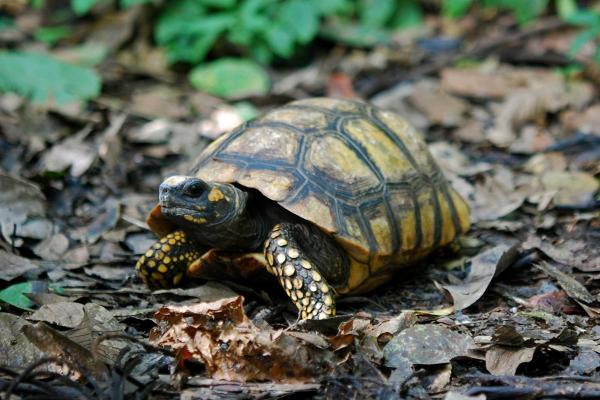
The Sahara spiny-tailed lizard
The Geyr's spiny-tailed lizard (Uromastyx Geyri) belongs to the genus Uromastyx. This genus is composed of more than 20 species that inhabit the desert areas and pre-desert of North Africa, India, Central Asia and the Middle East.
It measures an average of 35 cm long and 250 g in weight. It is one of the smaller species among Uromastyx lizards. Their habits are diurnal, feeding on grass, flowers and occasionally small insects. The Geyr's spiny-tailed lizard is a relatively small species in genus, meaning it does not have many options for prey other than insects.
It has a quiet character but if it gets nervous or feels attacked it uses its tail as a whip, as do the other lizards of the same genus. Their usual colors can be red, orange or yellow on a dark background and with lighter points studding all over the back and flanks. It inhabits rocky semi-arid areas of Algeria, Nigeria and Mali.
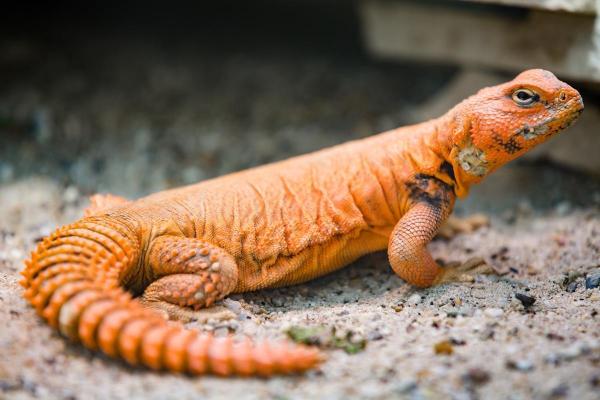
Green iguana
Perhaps a little controversial on our list of herbivorous lizards is the green iguana. They are considered mainly herbivorous and will even change the types of plant they will eat when the climate changes[1]. They feed on various types of vegetation, including collard greens, mustard greens and bougainvillea flowers. They can eat fruit, with wild green iguanas particularly loving yellow mombin or wild plums.
They use this vegetation to get the various minerals they need to survive, especially calcium and phosphorous. The controversy is found in whether pet green iguanas should be given animal protein. Some have been observed eating small mice without ill effects, but others think it can lead to dietary problems. What is true is that green iguanas do not need to eat animals and will thrive on a herbivorous diet.
Learn more with our guide to the diet of green iguanas.
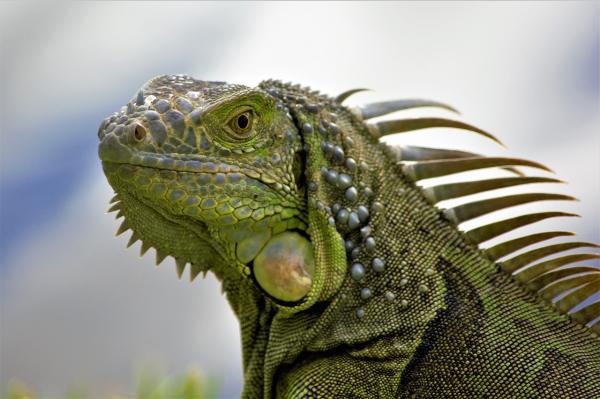
If you want to read similar articles to Which Reptiles Are Herbivorous?, we recommend you visit our Comparisons category.
1. van Marken Lichtenbelt W. D. (1993). Optimal foraging of a herbivorous lizard, the green iguana in a seasonal environment. Oecologia, 95(2), 246–256.
https://doi.org/10.1007/BF00323497












